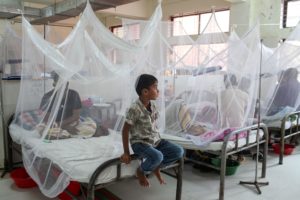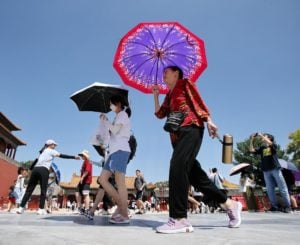Bangladesh is struggling to cope with a record-breaking outbreak of dengue, with the death toll climbing to 352 as of 9 August. Since January, 75,069 infections have been recorded in the country.
The daily dengue bulletin issued by the Directorate General of Health Services (DGHS) on 9 August said that in the previous 24 hours, over 2,844 new dengue cases were detected in Dhaka city alone, with 1,762 additional cases from various other parts of the country.
Dengue has no cure, so early detection is key
According to the World Health Organization, the prevention and control of dengue depends on limiting transmission of the virus. Although there is no specific treatment for dengue, early detection and access to medical care greatly lower fatality rates from the virus.
As monsoon rains wreak havoc in Bangladesh this week, claiming seven lives, there are fears that the dengue outbreak will get worse.
Writing in medical journal The Lancet, journalist Talha Burki says the surge in cases is not unexpected: “It is monsoon season in Bangladesh. Every downpour leaves multiple breeding spots for Aedes aegypti [mosquitoes], the primary vector for dengue in the country. El Niño, which is associated with increased temperatures in Southeast Asia, started in June, 2023. It has been linked to major dengue epidemics.”
Dengue was first detected in Bangladesh in the 1960s. The disease was then known as ‘Dacca fever’. Bangladesh has been witnessing an increasing trend of dengue fever since 2000. The dengue outbreak in 2019 saw the highest number of cases recorded – over 101,000 according to the World Health Organization – though total deaths were lower than in the current 2023 outbreak.
Based on the dengue statistics from eight divisions in Bangladesh for the 2021 to 2023 period, the highest infection rates have been recorded in Dhaka, Chittagong and Barisal. A World Bank study published in 2021 warned that dengue cases would likely increase in Dhaka, as the city has been experiencing falling humidity levels and rising temperatures along with erratic summer rainfall.
No break in cases from last winter
While dengue was once thought to be a seasonal disease in Bangladesh, outbreaks have occurred throughout the year for the past few years. Public health experts say dengue is becoming increasingly deadly due to a “lack of attention to dengue infections”.
Mohammad Mushtuq Husain is a public health expert and member of the Bangladesh Medical Association (BMA). In a recent seminar, Husain presented a paper in which he said: “Unplanned urbanisation, dense settlements, an unsanitary environment in villages and towns have [all] worsened the dengue situation. People are being infected by all four types of dengue virus now, which is a cause of national concern.”
Dengue infections are caused by four closely related viruses named DEN-1, DEN-2, DEN-3 and DEN-4. The four viruses are called serotypes, because each interacts differently with the antibodies in human blood serum.
It is difficult for five nurses to attend to 200 patients who need constant blood pressure checks and saline hydration dripsNiatuzzaman, director of Mugda Medical College & Hospital in Dhaka
Talking to The Third Pole, Husain says: “Actually, there was no break in the arrival of dengue patients in the hospitals between last year and this year. We got patients even in the winter. This time, we are getting more patients even a month and a half before the beginning of the season.
“There are four types of dengue among the infected. Among those who are now infected, the number of second-time infections is higher. Before 2000, we saw that people were infected with one form of dengue. As a result, a resistance would develop in them. But people are getting infected by all four types, so their immune system is not working well.”
Rashidul Haque, head of the Emerging Infections and Parasitology Laboratory at the International Centre for Diarrhoeal Disease Research in Dhaka, told The Lancet: “They [the authorities] are doing their best with the spraying and fogging, but it is very difficult.” Haque wonders whether the Aedes aegypti mosquito has now developed resistance to malathion, an insecticide used in Dhaka.
The Lancet report also says: “Aedes aegypti bites during the day, which limits the effectiveness of bednets; it is excellent at hiding and needs little more than a thimble-full of standing water to proliferate. Once it is inside a residence, it is extremely difficult to eradicate.”
Overwhelmed hospitals face staff and supply shortages
Hospitals in Bangladesh are struggling with the inflow of dengue patients. Niatuzzaman, the acting director of Mugda Medical College & Hospital, a 500-bed hospital in Dhaka, says his hospital is overwhelmed: “It is difficult for five nurses to attend to 200 patients who need constant blood pressure checks and saline hydration drips.” The hospital has a 60-bed children’s ward that is trying to accommodate 250 young patients.
As patient numbers increase, hospitals also face a severe shortage of saline. Khurshid Alam, a professor and directorate general of the Health Services of Bangladesh, says the government’s Essential Drugs Company Limited (EDCL) is responsible for supplying saline, but it is not able to meet soaring demand. Alam says the government has instructed the EDCL to ramp up supply and has allocated funds to each hospital accordingly.
Alam adds: “We have enough kits for dengue testing. The dengue testing system is available in all hospitals so that the kit [shortage] crisis does not occur.”
The EDCL’s managing director, Ehsanul Kabir, says: “Last year, there was a demand of six million bags of saline. Out of that, we were able to give 5,937,000 bags. Now, the demand is up to 12 times higher.” Kabir adds that the government is supplying saline to all government hospitals at a low cost.
Urban growth and climate change exacerbate dengue outbreaks
Experts believe that changing weather patterns have contributed to the increase of dengue in Bangladesh, exacerbated by poor water and sanitation management. In 2022, the health directorate carried out a pre-monsoon survey that found a “higher density of Aedis mosquitoes in Dhaka compared to the previous year”. That September, the Communicable Diseases Control (CDC) unit of the DGHS found that mosquito density was twice as high in Dhaka city as in its pre-monsoon survey.
Mohammad Shafiul Alam, a scientist at the Department of Infectious Diseases at the International Centre for Disease Research, Bangladesh told Prothom Alo that Aedes aegypti mosquitoes are highly adaptable to climate: “This type of mosquito changes its behaviour in any adverse climatic condition and reproduces in relatively dirty water.” Alam also told Prothom Alo that there is no in-depth data on the behavioural changes of mosquitoes in response to climatic shifts.
Talking to The Lancet, Kabirul Bashar, a professor at the Department of Zoology at Dhaka’s Jahangirnagar University, had this to say: “Our waste management system is not well-planned. Garbage piles up on the street; you see a lot of little plastic containers with pools of water in them. We also have multi-storey buildings with car parks in the basements. People wash their vehicles down there, which is ideal for the mosquitoes.”









